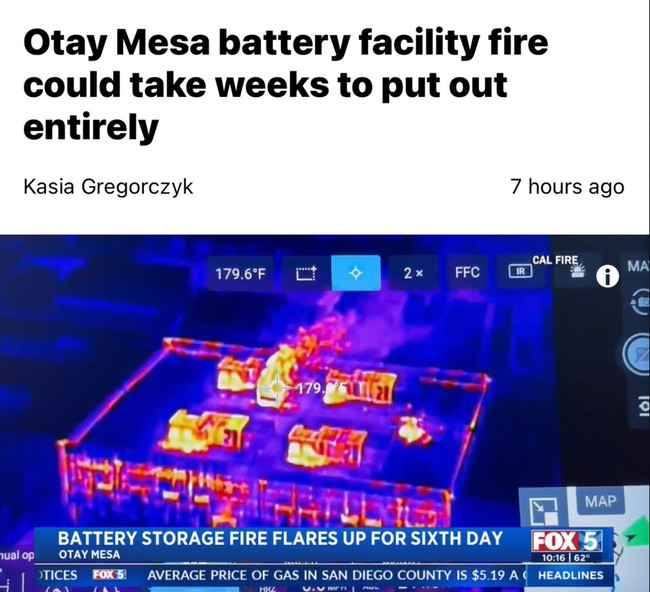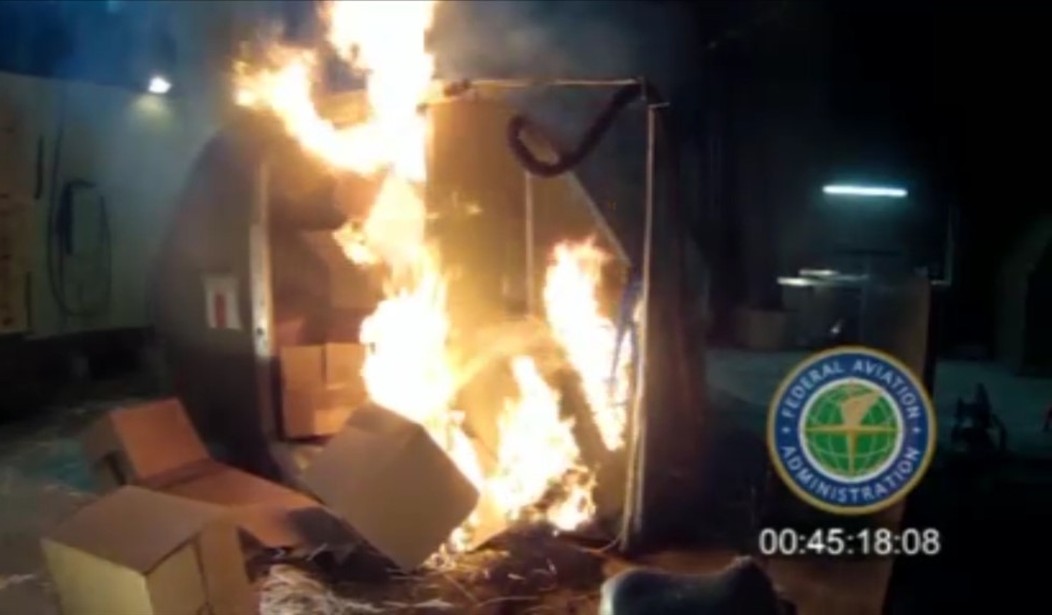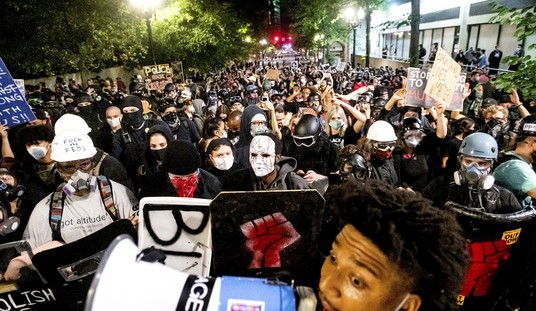It's not a laptop in first class or a cheap Chinese scooter smoking ominously in the plane's cargo hold. Nor is it a massive commercial ship packed to the gills with cars being transported across an ocean that has had one of the EVs parked onboard light off, and now the whole vessel is hopelessly ablaze. It's not another fiery EV in a driveway or garage or the solar panels on a rooftop, even though I have covered all of those.
Comments regular Global Traveler turned me on to an ongoing drama in, of all places, San Diego County that should be ringing alarm bells all over the country. His heads-up was the first I'd heard of it, and it's immediately obvious why.
Last Wednesday, the 15th of May, the Gateway Energy Storage Facility in Otay Mesa erupted into flames. It took firefighters an exhausting 24 hours to "extinguish" the blaze.
...The fire broke out inside the Gateway Energy Storage facility on Paseo de la Fuente Wednesday and took nearly 24 hours for crews to extinguish.
“When we arrived on scene there was light smoke showing,” Captain Mike Cornette with Cal Fire told FOX 5/KUSI on Thursday.
Businesses in the surrounding area were put on standby for evacuation while firefighters maintained a 600-foot safety barrier due to dangerous levels of hydrogen. A shelter in place order was also issued to Donovan State Prison, located about half a mile from the storage facility.
“We went into defensive action. We knew this was a battery storage facility. There’s some toxic gases and high heat that are attributed to that, so we called in extra support with the hazmat unit and the bomb squad to give us the extra tools,” Cornette explained.
Welp, they thought they'd extinguished it. By a week ago Friday, it had reignited and the CalFire representative on the scene was explaining "thermal runaway" to the local reporter. Fire crews were trying to contain the fire to the area where it had started while minimizing the opportunity for any deadly fumes it would produce to escape which would prompt evacuations of the - thankfully - largely uninhabited industrial area.
A fire at a battery storage facility in Otay Mesa reignited overnight, prompting a rapid response from firefighters that continued into Friday.
As of 7:40 p.m., the fire is still contained to the building of origin and there has been no structural damage, Cal Fire San Diego said in a post on X, formerly known as Twitter.
“Firefighters have deployed additional air quality monitoring equipment around the structure giving us the ability to lift evacuations,” the fire agency said.
By Saturday the 18th, every "put the fire out" bet were off. All firefighters could do was dump more water on the building and talk about "containment" as a goal, not extinguishing it. They had no idea how to put it out.
The long-smoldering battery plant fire in Otay Mesa neared the four-day mark Sunday with no indication that full containment was imminent.
Cal Fire Capt. Brent Pascua said mid-morning that the situation continued roughly as it was Saturday night with 40 firefighters and five engines assigned .
“We still have light wispy smoke coming from the fire,” Pascua said. “Our goal is to continue to keep it contained to the building it started in.”
There was no firm estimate of how much longer the fire might continue.
“Speaking with the experts, in the past they’re had a few incidents like this, and it’s anywhere from seven days to a couple of weeks,” Pascua said.
A stubborn fire at an energy storage facility in Otay Mesa reignited late Friday night and continued well into Saturday, as about 40 firefighters poured water into the location in the hopes of finally extinguishing the blaze.
At 8:23 p.m. Friday, Pascua said, a “significant fire” reignited inside one of the buildings at the Gateway Energy Storage Facility on Camino De La Fuente — the result of a chain reaction called “thermal runaway” that can occur when lithium-ion batteries overheat.
As of this past Tuesday, CalFire was still pouring water on and into the building while coming to the realization that "water" around lithium-ion batteries was a double-edged sword. Like Ramius tells Ryan in Red October, "Most things in here don't react too well to bullets." In the batteries' case, they don't react well to water.
...Pascua said things began to reignite Friday night.
“You have to put water on it to keep the fire confined, but that water damages the batteries also allowing them to arc starting another fire. We’re just trying to keep the public safe and keep the fire contained to the building,” he said.
The chain reaction can happen when a lithium-ion battery creates heat faster than it can dissipate. That rapid increase of temperature can then turn to fire.
But water's all they've got, and, as of yesterday, they were well into multiple millions of gallons flowing without having put the fire to bed.
San Diego Firefighters have flown in experts to the Otay Mesa Battery Storage site to study the fire because they don't know how to extinguish it. The 🔥 has already consumed 5 million gallons of water, and firefighters estimate it will take an additional 7-10 days to control,… pic.twitter.com/sVi71XW1Vy
— Amy Reichert (@amyforsandiego) May 23, 2024
One fire. In a perpetual drought state.
...The fire has already consumed 5 million gallons of water, and firefighters estimate it will take an additional 7-10 days to control, using a total of 15-20 million gallons. LETHAL amounts of Hydrogen Cyanide were present in the air for 3 hours after the fire began...
All that and, as of this morning, still en fuego. The thermal picture of the facility is pretty impressive too, as heat signatures go.

Where you run into problems going forward is that oleaginous California Governor Gavin Newsom's insane renewable energy policies have not only precipitously forced his state into near third-world energy status but are actively endangering his citizens. To meet CA's seemingly immutable NetZero goals and effect this marvelous transition, myriad copies of this very storage facility are being planned, with some permitted already, and a fair amount of them being dumped in the middle of residential areas.
Because "green transition."
Residents of Poway and Escondido have been fighting against a planned "Seguro Battery Storage Facility" for a good while now, and the Otay blaze has just added fuel to their arguments.
When you consider all the assets required for this one fire - which thankfully remains contained - in an isolated area, contemplating what might happen if one goes full bore when there are as many as 21 schools nearby, a hospital, and hundreds upon hundreds of homes? How is any suburban area a responsible possible site choice?
...The proposed battery energy storage facility would be built near the Eden Valley neighborhood.
...The facility in Otay Mesa is located at an industrial site, but the proposed North County site will be directly surrounded by homes, including 21 schools within a three-mile radius.
“These are chemicals that are really toxic and you really don’t want to have residents nearby. This is a completely different animal. We’re talking about what would be one of the largest battery facilities in the world. We’re talking about 216 forty foot long containers each one fueled with lithium-ion batteries," he added.
Rowley and other neighbors are now urging the county to deny the proposed site from going up.
Of course, you get the mewling "our batteries are different/better," "it's for the planet," but that's all a crock to residents who are rightly and should be militantly skeptical of claims when it's their health, safety, and community at obvious risk.
The funny thing was, I read a not-too-comforting report this morning where research is pointing to battery storage maintenance and monitoring as the cause of many of these fires, not the batteries themselves.
Like, "Oh, great," right?
...Their findings ultimately showed that many BESS failures can be prevented with better quality assurance and battery monitoring. Contrary to popular belief, the engineers determined only three failures could be traced to defects on the cell or module, underscoring the need for tools that enable improved commissioning and operational analysis of the entire system.
- 65% of failures could be linked to the operation and integration of batteries – not their manufacturing or design
- Just 11% of failures were due to battery cells and modules
“The report emphasizes the importance of battery analytics, with most of the failures traced to the integration and operation stages,” Franks said. “We believe this new resource will help guide further development of analytics software that can ensure BESS safety. We’re honored to support EPRI in the publication of this report and thankful for the collaboration of their engineers and those from PNNL.”
That should be even more concerning, for crying out loud.
As folks point out, officials foisting these projects on their citizens and the companies taking the money haven't begun to do the work on consequences. One guy basically said, when you can't even figure out how to put the fire out and you already knew these things burn, there are serious credibility problems.
...In La Mesa, residents and local leaders are wrestling with a renewable energy storage site proposed here on El Paso Street. Vice Mayor Laura Lothian is so opposed to it, she’s taken to social media.
“They have already gone through 5 million gallons of water. Can’t put out the chemicals,“ Lothian said in an Instagram post while standing in front of the Camino Fire. “This has no business being in La Mesa. We are building green energy initiatives that we have no idea what the consequences are."
San Diego-based Enersmart wants to build the La Mesa facility. That project is expected to begin in August.
Part of the company’s project overview on its website reads: “Our storage projects prioritize safety. The La Mesa site will use lithium iron phosphate batteries which are a chemically and thermally stable battery technology.”
With the current state of the Camino Fire, residents can’t help but wonder whether it could happen in their communities.
“If they can’t figure out how to put that fire out, these batteries have been a problem for everything,” Show said.
The companies say these projects are generally being created to support the electrical grid during times of high use. They are also part of several community efforts to transition to clean energy use.
Battery storage facility fire will take *WEEKS* to put out, and yet, they want to put 2 more in the SD area near homes/businesses. What could possibly go wrong? https://t.co/ArVLUw2iOk
— Col Alois Hammer (@andyinsdca) May 21, 2024
Yeah. What could possibly go wrong?
They've already had a taste of it.
The problem I'm seeing with more of the protests is the "well, we need to have this for our energy transition, but NOT HERE" that almost every last person protesting starts their objection with. That needs to change.
You DON'T NEED ANY OF IT for an energy "transition" YOU DIDN'T NEED and never "needed" to begin with.
What Californians do need to do is to wake up and reject the NetZero mandates, period.
If the first words of your protest are already acceptance?
You already surrendered.
In the meantime, Otay still ain't okay.
It'll be smokin' away for the foreseeable future.
********************************************
BEEGE UPDATE: So here it is 24 hours after I put this report up - and thank you guys in the comments for the rip-roaring discussion, by the way - and fire crews are describing it as "beginning to calm down" after ten days.
Oh. That's better...right?
Firefighting efforts continue to improve containment of a commercial structure fire that broke out 10 days ago at an energy storage facility in the Otay Mesa area, officials said Saturday.
Units were dispatched in the early afternoon of May 15 to Lithium Ion Batteries at 641 Camino De La Fuente, a 13,600-square-foot battery and energy storage facility in an industrial part of San Diego County.
"The evacuation order at Grid 0436 has been downgraded to a warning due to improved atmospheric conditions, and the evacuation warning for Grid 0437 has been removed,'' Cal Fire officials reported.
A road closure was also in effect at Camino De La Fuente at Paseo De La Fuente, according to Cal Fire.
No expected "time of full containment" has yet to be announced.
YOICKS







Join the conversation as a VIP Member